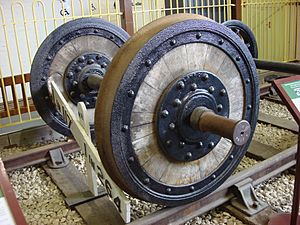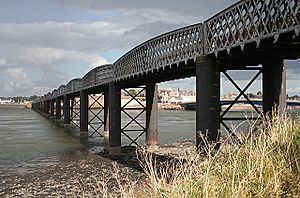William Yolland facts for kids
William Yolland was an important English military surveyor, astronomer, and engineer. He lived from 1810 to 1885. He became Britain's Chief Inspector of Railways in 1877 and worked hard to make trains safer. This was a time when railway companies were more focused on building new lines than on preventing accidents. He was also part of the team that investigated the terrible Tay Bridge disaster.
Contents
William Yolland's Career
William Yolland was born in Plympton St Mary, Devon. His father was a land agent and encouraged William's interest in surveying. William went to a special school for mathematics. In 1828, he joined the Royal Engineers, which is a part of the army that deals with engineering. He finished his training in 1831.
Working for the Ordnance Survey
After serving in the army in Britain, Ireland, and Canada, Yolland joined the Ordnance Survey in 1838. The Ordnance Survey is the national mapping agency. He was very good at mathematics and wrote about astronomy. In 1846, the head of the Ordnance Survey suggested Yolland should take over. However, he was thought to be too young.
Instead, an older officer was chosen. This officer sent Yolland to Ireland. It turned out to be a very important job! Parliament was losing money because land taxes weren't up to date. Yolland's mapping work in Ireland helped fix this. In 1849, he was asked to explain how his mapping methods could be used in England to help with new town sanitation plans.
Yolland's work in Ireland is even part of a modern play called Translations. In the play, a character named George Yolland is based on him, but the story is fictional.
When he returned to England, Yolland was put in charge of the Ordnance Survey's new offices in Southampton. He created maps of Southampton and, with Captain Tucker, a map of York in 1852.
In 1851, Yolland helped judge the military engineering section at The Great Exhibition.
When the head of the Ordnance Survey retired in 1854, many expected Yolland to finally get the job. But the old head, who didn't like Yolland's skills, stopped him from getting it. Yolland then left the Ordnance Survey.
He joined the Railway Inspectorate of the Board of Trade. This group was always staffed by Royal Engineers officers. Yolland, who was still an army major, easily got a job there. He also helped create a report on how to train military officers in science and technology. His ideas were used for many years.
Making Railways Safer
Yolland left the army in 1863, as a lieutenant-colonel, but he stayed with the Railway Inspectorate. At this time, Britain was building many new railway lines. Yolland's job included inspecting these new lines. He always insisted that the newest safety features be used. These included signal interlocking (which makes sure signals and points work together safely) and block working (which keeps trains a safe distance apart).
Yolland also pushed for continuous automatic brakes on trains. He liked a system invented by James Newall. At that time, the Inspectorate couldn't force existing railway lines to make changes. So, Yolland often wrote detailed reports about how accidents happened because of poor organization or neglect.
In 1877, he became the Chief Railway Inspector. He passed away on September 4, 1885, in Atherstone, Warwickshire.
Shipton-on-Cherwell Accident (1874)
One of the worst train crashes Yolland investigated happened near Oxford on the Great Western Railway. On December 24, 1874, a passenger train derailed and crashed down an embankment near Shipton-on-Cherwell.
Yolland quickly found the cause. By looking at marks on the railway sleepers (the wooden beams under the tracks), he saw that a small four-wheel carriage behind the engine had a broken wheel rim. This broken wheel caused the train to derail. The driver braked hard, and the carriages behind crashed into the four-wheeler, crushing it and themselves. The accident happened near a bridge over the Oxford canal. Thirty-four passengers died from their injuries.
Tay Bridge Disaster (1879)
Yolland was part of the inquiry into the Tay Bridge disaster. On December 28, 1879, a train was lost while crossing the Tay estuary near Dundee. The middle part of the two-mile-long bridge collapsed during a storm, and everyone on the train died.
The inquiry first met in Dundee to hear from people who saw the accident. Then they met in London for expert opinions. Their final report in June 1880 said the bridge was "badly designed, badly built and badly maintained."
Yolland then looked at other bridges designed by the same engineer. He found a very similar bridge at Montrose, called the South Esk Viaduct, was in very bad shape. Its supports were not straight. Yolland tested it, and it failed. He said it needed to be torn down and replaced with a stronger, double-track bridge. The railway company didn't want to spend that much money. They built a cheaper, single-track replacement instead.
Honours and Awards



